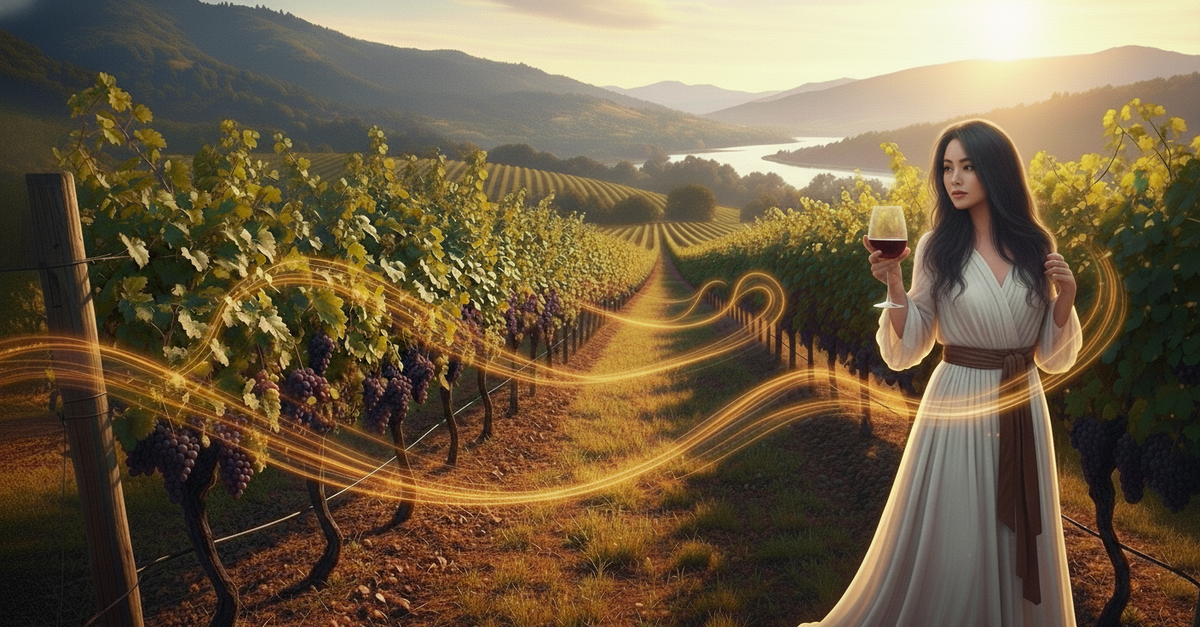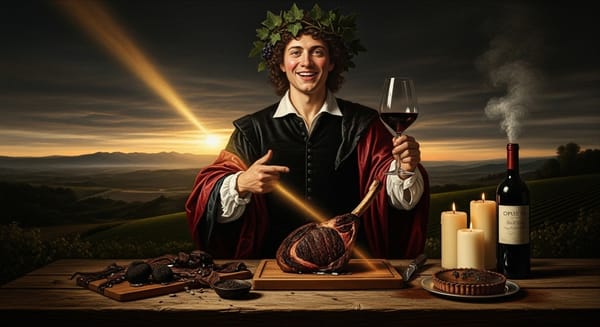Sonoma: Where the Vine Dreams and the Pacific Answers
Sonoma isn’t a postcard; it’s a collision. Pacific fog barrels inland, sun pushes back, and vines thrive in the tension. From Russian River Pinot that crackles with cranberry to Dry Creek Zinfandel built like a redwood, meet growers who turn contradiction into pure kinetic flavor.

Sonoma is a county, a brand, and a battle line, yes. But more than any label, it is a mood: half‑wild, half‑tender, always in motion. Imagine a violinist practicing Paganini on a surfboard—grace perched on top of chaos. That is the daily posture of every vine rooted here. Expand the metaphor and you have the wines themselves: poised, kinetic, and always one wave away from being flung into something entirely new.
The Shock of the Shore
Stand at Bodega Head at dawn, feet sinking into sand cold enough to numb your courage. Light hurls itself against water; the water snarls back; wind rushes up the cliff as if late for confession. This collision—bright heat versus frigid brine—is the marrow of Sonoma. Every vine is born in friction and flavored by it. The result is abundance streaked with austerity: gold‑green leaves flashing under Californian sun, grapes filled with flower‑shop aromatics, yet wines that hum with a cool, bracing ache that makes your shoulders tilt inward, the way you lean over a love letter you’ve reread too many times.
These wines refuse the postcard grin of “sunshine in a bottle.” Instead, they deliver chiaroscuro: texture against velocity, citrus snap against velvet mid‑palate, a flavor cadence that races forward then pulls you back like tidewater against your ankles. One sip can swing you from quince‑bright morning into a dusk that smells of wet redwood bark and flirts with melancholy. Sonoma is not interested in monologues; it’s a place of duets, countermelodies, harmonics you only catch on the third listen.
Rebellious Roots – Faith, Grit, Renewal
The birth certificate of Sonoma wine is written in ecclesiastical Latin. Franciscan missionaries, pockets full of Mission grape cuttings and souls full of deliverance, planted vineyards near the Sonoma Plaza in the early 1800s. The wines were coarse and devotional—altar rather than altar‑piece—but they set roots both literal and cultural. Where faith pointed, vines followed.
Enter Count Agoston Haraszthy, the swaggering Hungarian whose résumé read like an opera libretto—nobleman, sheriff, entrepreneur, drinker of big ideas. In 1857, he founded Buena Vista, imported 300‑plus European varieties, and declared that California would one day eclipse Bordeaux. He nearly drowned in the Mississippi, wrestled with bankers, and finally succumbed to alligators in Nicaragua—yet his fingerprints linger on every modern Pinot and Chardonnay that dares to talk terroir.
Prohibition tried to prune the dream, but Sonoma growers went guerrilla. They made sacramental wine in side‑rooms, shipped grapes east in wooden crates labelled “DO NOT FERMENT,” and kept journals of field‑blend recipes in family Bibles. When Repeal arrived, Sonoma didn’t just reboot; it rebooted with attitude. The mid‑century pioneers—Joe Swan with his garage Pinot, the Rochioli family planting Dijon clones in river fog, the Sausal brothers preserving 19th‑century Zinfandel vines—embraced heterodoxy. They believed dirt could dictate style, that small was beautiful, that mistakes were teachers, not blemishes. In doing so they minted a lineage of stubborn innovation that still fires the county’s pulse.
Geography in Fast‑Forward
Mapmakers see Sonoma as 1,768 square miles of land. Vintners measure it in minutes of fog. Cool marine air sprints through the Petaluma Gap like a street racer, brakes over the Russian River, and stalls along the Sonoma Coast, laying a blanket so thick dawn looks like dusk. Meanwhile, just twenty miles inland, Alexander and Dry Creek Valleys bank sunlight the way dragons hoard gold, minting Cabernet and Zinfandel with broad shoulders, sun‑soaked tannins, and a kind of slow‑rolling power you feel rather than taste.
Beneath your hiking boots, chaos reigns. River‑laid loam nestles up against fractured andesite; sandstone shoulders serpentine; volcanic shards glitter under a dusting of ancient seabed. Dig a three‑foot trench on one hillside and you’ll find pebbly, well‑drained soil that forces the vine to dive deep; dig again 20 paces north and you’ll hit clay that hugs moisture like a secret. There is no single “Sonoma soil.” Instead, think of an art school collage sewn from tectonic tantrums, river tantrums, and the quiet revisions of millennia. Ask a vine to translate it and you get fruit that tastes like iron filings, lavender smoke, or sun‑warmed raspberry, depending on which foot of slope or breath of wind it’s clutching.
Climate cartwheels, too. Afternoon highs can surge to 95 °F in Alexander Valley while the Sonoma Coast sips 65 °F and a sweater. Yet—as every old‑timer here will tell you—it’s not the daily high that dictates style; it’s the nighttime low. Cool evenings preserve acidity, stretch hang‑time, and let flavors layer up like geological strata. Sonoma’s secret weapon isn’t heat; it’s the cool that follows the heat.
Farming by Braille
In Sonoma, a vineyard manager is less commander than interpreter, fingers on the vine’s pulse, eyes on the sky’s mood swings. A 40‑degree temperature swing can unfold between first coffee and last call. Canopy becomes theater curtain: open here to shoo mildew, close there to dodge sunburn. Irrigation is triage, not habit; pruning is architecture, not haircut. The goal is paradoxical—restrained ripeness, generous tension.
Let’s walk a morning with Maribel, third‑generation grower in Sebastopol Hills. Dawn fog beads on her jacket as she lifts vine leaves, checking for botrytis. She pinches a Chardonnay berry, notes the subtle crackle of the skin—too fragile means too much water, too leathery signals stress. She decides today they’ll pull leaf‑layers on the east side of every Pinot row, giving the clusters one extra hour of morning light. West sides stay shuttered until heat index drops. Each decision whispers the same question: How do I keep the acidity’s song while ripening the fruit’s chorus? Farming here feels like reading braille on the palm of a moving hand—you sense patterns, but they’re never still long enough to memorize.
Organic and biodynamic practices aren’t marketing slogans so much as survival strategies. Cover crops anchor fragile slope soils and host beneficial insects that out‑gun spider mites; compost teas nudge microbial life into symphony; lunar calendars dictate pruning not because of mysticism but because 100 years of observation says sap flow listens to tides. Sonoma’s greatest luxury is choice; its greatest discipline is knowing when to let nature finish the sentence.
Cast of Characters – Grapes and Their Stages
Pinot Noir
Sonoma’s emotional tenor. In Russian River’s river‑fog cradle, Pinot comes off ripe—cherry cola, plum pulp, a velvet sigh—but still framed by sandalwood and sassafras. Move west to the Sonoma Coast’s cliff‑hanger vineyards and the wine tightens: cranberry, rose petal, iodine, a bright wire of acidity that stands your palate at attention. These are wines that age like dancers—supple now, sinewy later, never losing grace.
Chardonnay
The county’s shapeshifter. In warmer inland sites, it offers pear tart, crème brûlée, and a buttery glide. Shift to wind‑laced Carneros or the blustery ridges near Occidental, and it slips into lemon curd, crushed oyster shell, and the tensile poise of a high‑wire act. Stir the lees gently—or not at all—and you get texture that feels like silk ribbon catching a gust.
Zinfandel
Old‑vine exuberance bottled. Dry Creek Valley’s centenarian blocks toss blackberry jam into a pepper grinder, adding hints of fennel pollen and dark cocoa. The alcohol nudges north, yes, but the best wines carry a balsamic lift that keeps the swing party on beat rather than sloppy.
Cabernet Sauvignon
Alexander Valley’s cab is graphite wrapped in cassis velvet—a muscular handshake delivered by someone who still pulls out your chair. Tannins are broad but sanded smooth; oak adds cedar cigar box, not colonizing vanilla. These wines reach middle age gracefully, shedding gym muscle for philosopher’s shoulders around year ten.
Rhône Fault‑liners
Grenache, Syrah, Mourvèdre thrive on rocky knolls where sun ricochets off stones. Expect smoked plum, black olive, charred rosemary, and a crackling energy that feels like summer thunder behind granite clouds. They broaden Sonoma’s spectrum, adding baritone to a choir heavy on alto and tenor.
Cellar Philosophy – Transparency vs. Transformation
Cellar doctrine here is a gallery, not a church. The cool‑climate Vanguard lets native yeast run barefoot, ferments cool, and ages in neutral oak that whispers instead of shouts. They’re chasing texture—silk, satin, sometimes raw linen—and clarity that lets soil talk first. Think Littorai or Peay: wines that taste like fog made audible.
Then there’s the Heritage Guard—producers crafting Cabernet, Merlot, or flagship Zinfandel who lean into extraction, extended maceration, and new French barrels. Their goal is architecture: wines that can stand like a redwood grove for decades. Ridge’s Lytton Springs is the north star here, building tannin ladders sturdy enough for time to climb.
In between sits a wide river of stylistic crossovers embracing concrete eggs, amphora, or hybrid oak‑forest barrels. Regardless of method, the litmus test is balance: acid that lifts, tannin that guides, fruit that converses but doesn’t monopolize. Power without posture is sprawl; finesse without flesh is a ghost. Sonoma’s best bottles thread that needle, turning contradiction into counterpoint.
Keepers of the Flame — An Expanded Cast
Sonoma’s greatness is carried on many shoulders, some broad with history, others wiry with insurgent energy. Think of this as a constellation map: each star points the way, but together they sketch the full shape of the county’s restless spirit.
Patrons of Precision
- Kistler — Still the north star for single-vineyard Chardonnay. Their Les Noisetiers bottling marries Meursault texture to Pacific acidity, proving that power can pirouette.
- Littorai — Ted Lemon’s cosmic biodynamics channel fog into Pinot Noir that tastes like crushed oyster shell stirred into pomegranate tea. Silence in motion.
Guardians of Heritage Vines
- Ridge Vineyards – Lytton Springs — Old-vine field-blend Zinfandel that ages like mahogany—spice-polished, story-saturated, structurally indestructible.
- Bedrock Wine Co. — Morgan Twain-Peterson MW resurrects heirloom vineyards from the 1880s—Carignan, Mourvèdre, and even Alicante Bouschet—bottling California’s immigrant history with punk-rock verve.
Garage to Icon
- Williams Selyem — The original Russian River garage Pinot that traded milk checks for barrels; today it’s all waiting-list whispers and silk-textured fruit that sets auction paddles twitching.
The Avant Garde Minimalists
- Arnot–Roberts — Tyrus and Duncan ferment in concrete, favor whole clusters, and let Syrah and Trousseau speak in lightning bolts and graphite dust. California in lowercase italics.
- Pax Mahle Wines — Whole-cluster North Coast Syrah fermented like Beaujolais, bottled like Côte-Rôtie, priced for weeknight enlightenment.
New-Wave Storytellers
- Scribe — Two brothers, a centenarian mission site, and skin-contact Chardonnay that tastes like citrus peel steeped in jasmine. Parties on the hacienda porch feel like Napa 1969—with better playlists.
- Raen — Carlo & Dante Mondavi scale the rugged Sonoma Coast, coaxing Pinot Noir that smells of wild strawberries crushed on granite, dressed in a whisper of sea wind.
Knight’s-Valley Grandeur
- Peter Michael — Mountain-slope Cabernet Sauvignon (Les Pavots) and Burgundian-minded Chardonnay (Belle Côte) that prove opulence can wear hiking boots.
Age, Serve, Listen
Great wines don’t just mature; they develop memory. Coastal Pinot wants 58 °F and a plate of seared duck breast or porcini risotto so its forest‑floor aromatics find echo. Five to twelve years unveil sous‑bois, truffle, and hibiscus tea. Zinfandel struts at 65 °F beside barbecue pulled‑pork, its peppery spark lighting the smoke. Cabernet prefers a decant, a porterhouse, and a fireplace conversation; fifteen years trades primary cassis for cedar chest, graphite edge, and the hush of library corridors.
Service rituals here honor tension: chill to elevate aromatics, wide‑belly glass to relax structure, food that respects acidity. Remember: temperature is volume control; glass shape is equalizer. When you hit the sweet spot, Sonoma wines talk back in full sentences, not one‑word replies.
Investment with a Pulse
Auction houses chase Napa cult labels, but Sonoma’s treasures live in micro‑lots often under 1,000 cases. Coastline Pinot from sites like Coastlands, Platt, or Falstaff; old‑vine Zinfandel from Bedrock’s Heritage vineyards; skin‑contact Chardonnay experiments that sell out via email in eight minutes. These aren’t stocks; they’re love letters with corks. Value grows less in decimal points than in heartbeat spikes when you share a 20‑year bottle with someone who thought wine couldn’t taste like ocean fog trapped in cherry skin.
Still, scarcity and critical praise mean prices creep. Smart collectors hunt mailing lists early, cellar with precision, and pull corks with intention rather than exhibitionism. The return is emotional equity—liquid narrative that lets you replay a vintage’s weather patterns, labor choices, and wild guesses in one long, slow sip.
Epilogue – Drinking on the Edge
Open a bottle from Sonoma and you agree to its terms: light versus cold, generosity versus restraint, coastline versus valley floor. What you pour is a mood ring for the human condition—restless, resilient, endlessly curious. It is wine as perpetual motion, an endless echo of morning fog and afternoon blaze, of iron‑rich soil and water‑cooled night. One glass tells a geologic saga; one bottle invites you to stand at the county’s edge and feel the Pacific fling salt on your face.
Wine should never be a mirror; it should be a window. In Sonoma, that window opens onto the ledge where longing becomes liquid, and where every sip whispers—Stay curious, hold fast, the edge is where life glints brightest.





